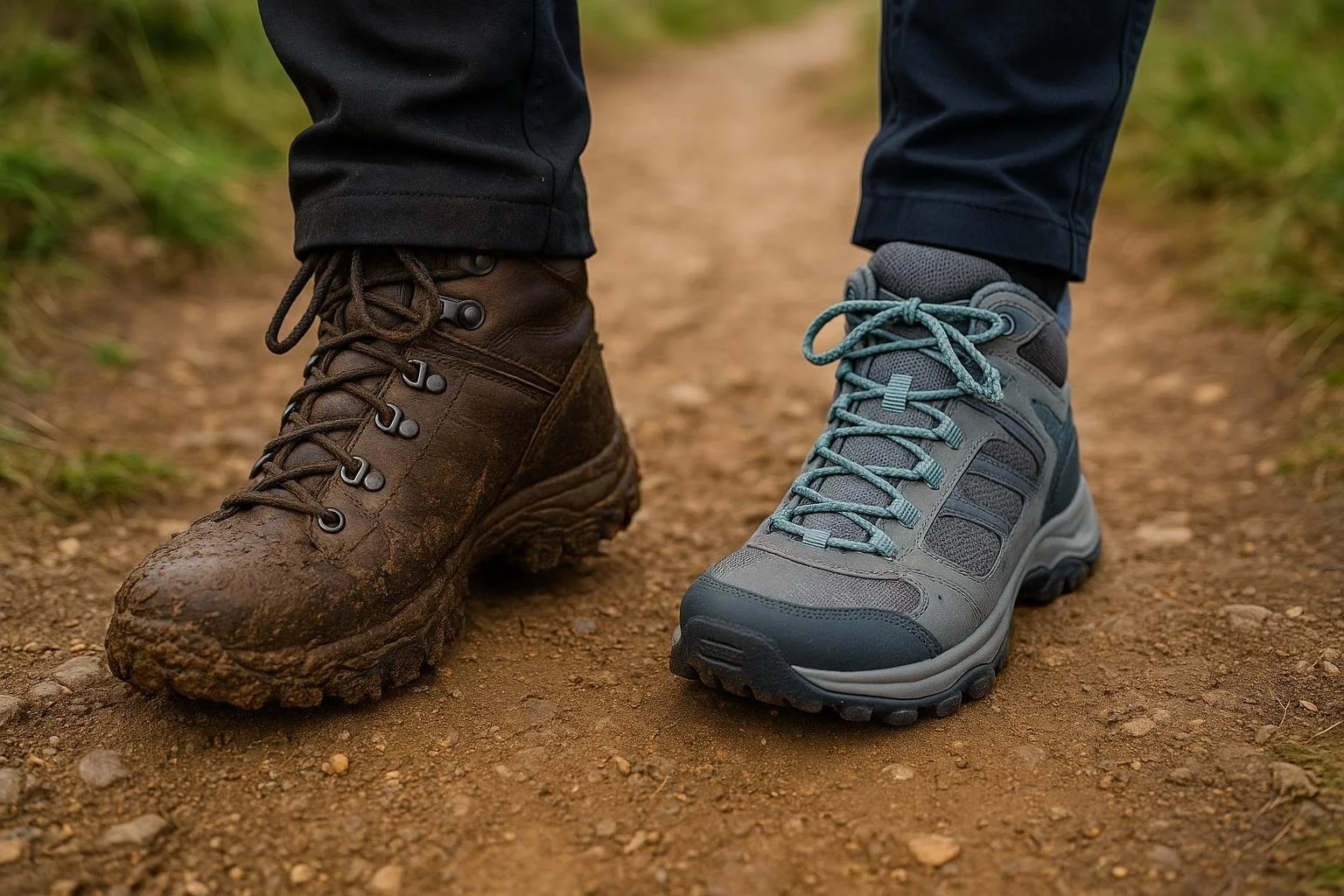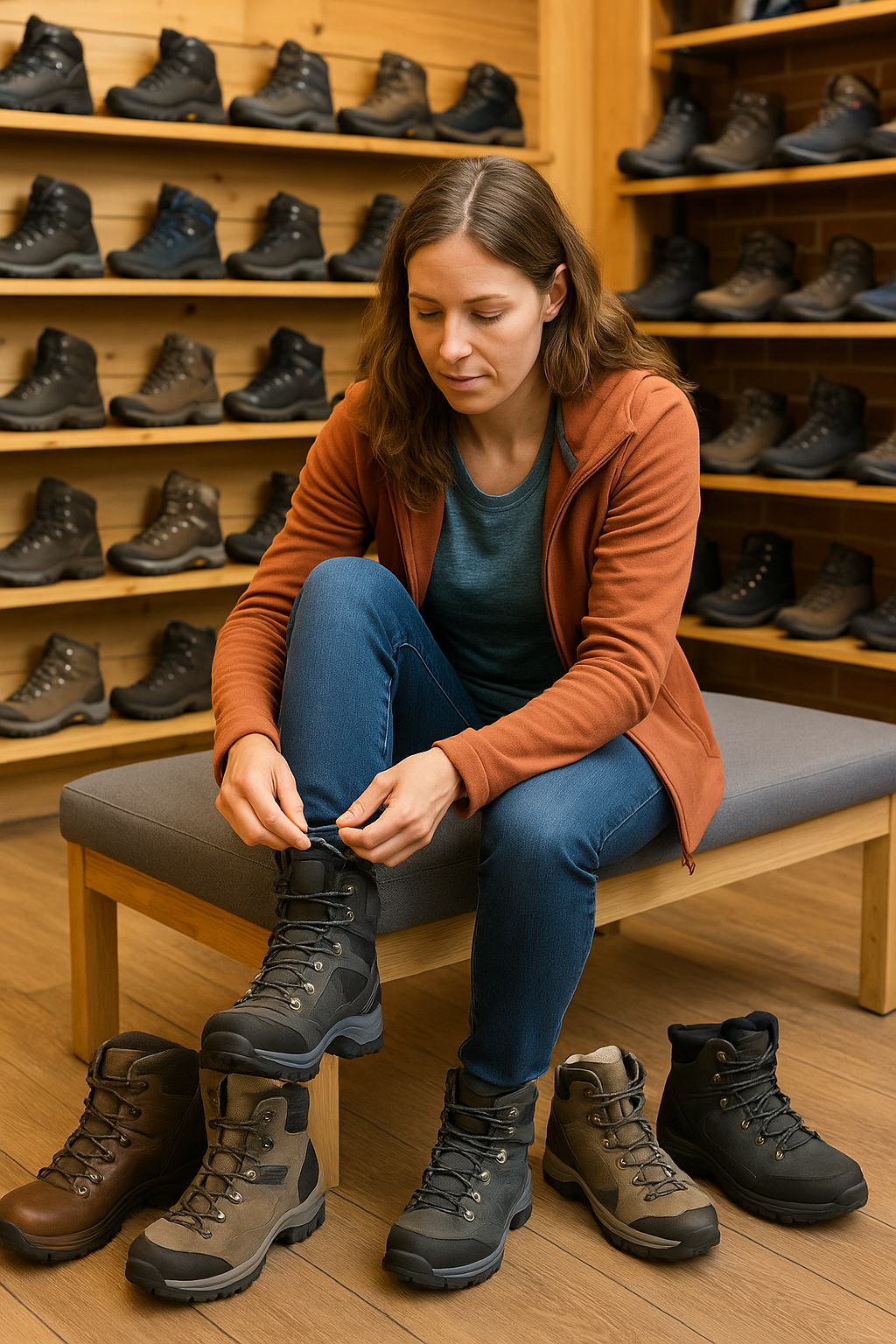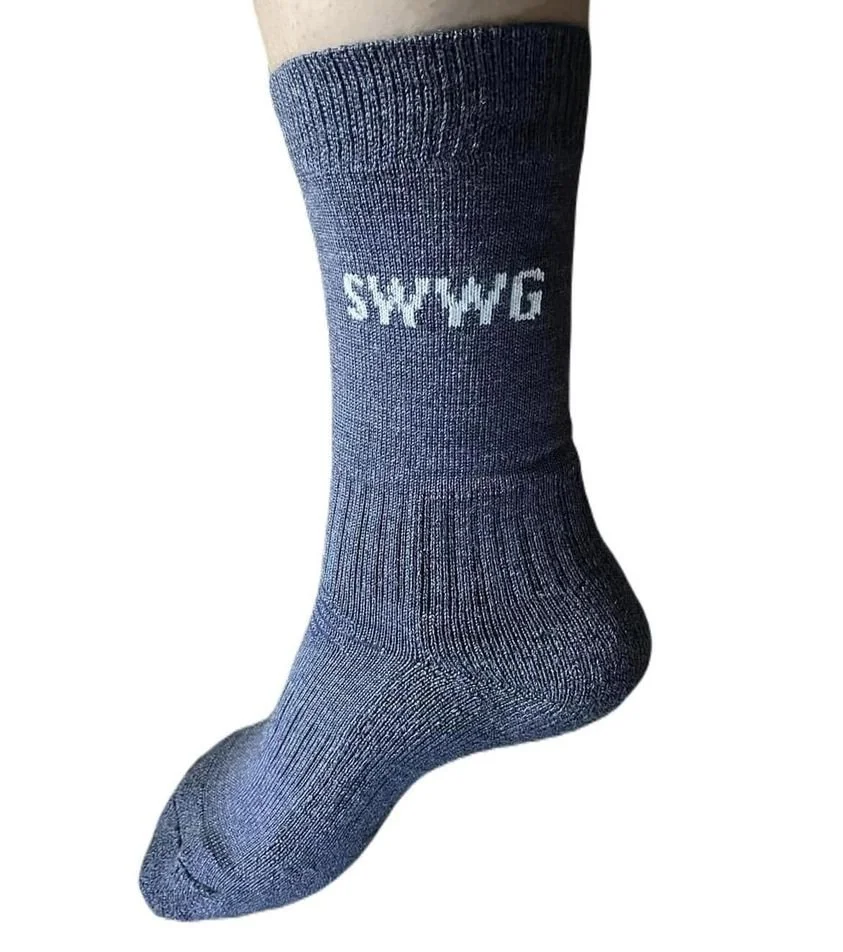Choosing the Right Footwear for Every Kind of Walk
If you ask any experienced walker what the most important bit of kit is, they’ll probably say “footwear” before you’ve even finished the question.
Your boots or shoes are the foundation of every single step. Get it right, and you can walk all day with a smile on your face. Get it wrong, and you’ll be limping, blistered, and plotting your escape route back to the car.
We’ve all done it! Set out in trainers because “it’s only a few miles” and ended up soaked to the ankles, sliding around in mud, or feeling every stone through the sole. A bad choice of footwear can turn a brilliant day out into a misery march.
So, let’s talk about how to choose the right footwear for your walk and why a pair of good socks can be just as important.
Start With the Walk You’re Doing
The best footwear choice depends entirely on where you’re walking, how far you’re going, and what the ground’s doing under your feet. Picking the wrong style can turn a pleasant wander into a painful trudge - or worse, leave you with wet socks, aching arches, and a bad mood.
Short Local Strolls
Examples: Park circuits, village streets, woodland paths in dry weather.
Best footwear: Walking shoes or cushioned trainers with decent grip.
Why: You don’t always need heavy boots for flat, predictable surfaces - lighter footwear keeps things casual and comfortable.
SWWG Tip: Check the forecast. If there’s rain, even “easy” routes can turn into slippery mud traps.
Countryside Rambles
Examples: Forest and Farm tracks, canal paths, rolling fields, and bridleways.
Best footwear: Lightweight hiking boots or sturdy walking shoes with waterproofing.
Why: These routes can hide uneven ground and muddy patches, especially after rain.
SWWG Tip: Look for a balance of support and flexibility, you might cover more miles than you expect.
Hill walking & Munros
Examples: Steeper climbs, rocky paths, exposed high ground.
Best footwear: Sturdy, supportive boots (mid- to full-height) with aggressive tread for grip.
Why: Hills demand ankle stability, solid soles, and good grip to handle loose rock, scree, or wet grass.
SWWG Tip: If the walk includes stream crossings or boggy sections, waterproof boots are your best friend.
Wet or Boggy Terrain
Examples: Moorland, marshy paths, sections of the West Highland Way after rain.
Best footwear: Fully waterproof boots with a solid sole; gaiters to keep water and mud out.
Why: Dry feet = happy walker. Wet, cold feet can sap your energy fast.
SWWG Tip: Even in summer, Scotland can serve up “surprise” bogs that are ankle-deep.
Winter & Icy Conditions
Examples: Icy paths, snow-covered hills, frozen tracks.
Best footwear: Insulated boots with deep tread, or boots compatible with microspikes/crampons for added grip.
Why: Cold + slippery = a bad combination. Proper winter boots keep you warm and upright.
SWWG Tip: Even if the glen is snow-free, the summit could be icy - pack traction aids just in case.
Mixed Terrain/All-Day Walks
Examples: Long-distance trails, charity hikes, multi-section day walks.
Best footwear: Comfortable, broken-in boots that offer a balance of support, cushioning, and weather protection.
Why: You’ll likely encounter multiple surfaces, from tarmac to tussock - so a versatile boot wins.
SWWG Tip: This is where knowing your own feet really pays off, comfort over fashion every time.
Your Footwear Options
There’s no such thing as “one pair fits all walks.” The best choice depends on the terrain, weather, and how far you’re going. Here’s the breakdown:
Walking Shoes
Best for: Short, easy walks on dry, well-maintained paths.
Pros:
Lightweight and flexible - feel more like trainers.
Great breathability for warm weather.
Comfortable straight out of the box.
Cons:
Little to no ankle support.
Not ideal for very wet or muddy conditions.
Less durable than boots on rough terrain.
Lightweight Hiking Boots
Best for: Mixed-terrain walks, countryside rambles, low-level hills.
Pros:
A good balance between support and flexibility.
More ankle protection than walking shoes.
Usually waterproof but still breathable.
Cons:
Not as robust as heavier boots for serious mountain use.
Some models can still feel a bit “clumpy” if you’re used to trainers.
Mid-Height Boots
Best for: Hillwalking, long-distance trails, rocky or uneven ground.
Pros:
Extra ankle support without the full weight of a high boot.
Good stability on uneven terrain.
Often more weather-resistant than low-cut shoes.
Cons:
Slightly heavier than low boots/shoes.
Can feel warm in summer.
SWWG Tip: Ideal for Scotland’s “four seasons in a day” days - solid enough for hills, comfy enough for longer, flatter stretches.
Full-Height Boots
Best for: hills, rugged upland paths, multi-day hikes.
Pros:
Maximum ankle support and stability.
Built to handle steep, rocky, or boggy conditions.
Often the most durable option.
Cons:
Heavier and stiffer than other styles.
Take longer to break in.
SWWG Tip: These are the boots you want when you’re miles from anywhere and need your footwear to cope with anything.
Trail Running Shoes
Best for: Fast walking, well-drained trails, dry summer conditions.
Pros:
Very light and flexible.
Excellent grip for speed on varied terrain.
Dry quickly if they get wet.
Cons:
Minimal ankle support.
Little insulation in cold weather.
SWWG Tip: Great for speed and agility, but be ready for wet socks if the path is muddy.
Wellington Boots
Best for: Short, flat, muddy field paths or farm tracks.
Pros:
100% waterproof (if there are no holes!).
Easy to clean.
Cons:
No cushioning or arch support.
Can cause rubbing and fatigue on longer walks.
Not breathable - feet can sweat and get cold.
SWWG Tip: Good for short winter dog walks or village puddle-hopping, but don’t try a longer walk in them.
Approach Shoes (bonus option)
Best for: Rocky scrambles, mixed walk-and-climb days.
Pros:
Sticky rubber soles for grip on rock.
Low profile but tough.
Cons:
Limited ankle protection.
Can be heavier than standard walking shoes.
SWWG Tip: Niche, but brilliant if your walks sometimes turn into mini climbing adventures 🤣
Key Features to Check
Buying walking footwear isn’t just about the style or colour - it’s about how well they’ll keep your feet happy, dry, and supported over miles of mixed terrain. Here’s what to look for (and why it matters):
Waterproof vs. Water-Resistant
Waterproof boots use membranes (like Gore-Tex) or coatings to keep water out - ideal for boggy paths, wet grass, and Scotland’s “surprise” downpours.
Water-Resistant boots will handle light rain or damp ground but won’t cope with prolonged soaking.
SWWG Tip: If you walk in Scotland, assume you’ll meet wet ground. True waterproof boots are worth it, but remember they may be less breathable on hot days.
Breathability
Lets moisture from sweat escape, keeping your feet dry on the inside as well as the outside.
Look for mesh panels or breathable waterproof membranes.
SWWG Tip: Overheating feet = sweaty socks = blisters. Breathability is a comfort feature you’ll appreciate after a few miles.
Ankle Support
Higher-cut boots stabilise your ankle and reduce the risk of twisting on uneven ground.
Lower-cut shoes feel freer but offer less protection.
SWWG Tip: If you’ve ever turned your ankle on a rut or rocky path, you’ll know why this matters.
Grip & Tread Pattern
Deep lugs are great for mud and loose gravel.
Shallower tread patterns can work better on mixed or hard-packed surfaces.
Look for rubber compounds that perform well in the wet.
SWWG Tip: Imagine the terrain you walk most often — you want soles that bite into it, not slide across it.
Weight
Heavy boots offer more protection and durability but can tire your legs faster.
Light boots or shoes feel nimble but may offer less underfoot protection.
SWWG Tip: Try on both heavy and light pairs - you’ll instantly feel which suits your walking style.
Flexibility vs. Stiffness
Flexible soles are comfier for easy trails.
Stiffer soles give stability and support on rocky ground and when carrying a pack.
SWWG Tip: If you feel every stone through your boots, you probably need something stiffer.
Fit Is Everything
You can buy the most expensive, high-tech boots in the shop, but if they don’t fit your feet properly, they’ll still be torture devices.
Good fit isn’t just about comfort - it’s about preventing blisters, bruised toenails, twisted ankles, and even long-term joint problems.
Start With the Right Size
Measure Your Feet Properly – Our feet change shape over time, so don’t assume your shoe size hasn’t shifted since high school. Many outdoor stores offer free foot measuring.
Account for Sock Thickness – Try boots on with the socks you’ll actually wear walking. A thicker sock means you may need half or a full size up.
Allow Wiggle Room for Toes – You should be able to move your toes without them hitting the front of the boot.
Check Heel Hold
Your heel should sit snugly without lifting when you walk uphill. Heel lift = friction = blisters.
A boot that’s too loose at the heel can also make you feel unstable on uneven ground.
Lacing Makes a Difference
Learn different lacing techniques (heel lock, surgeon’s knot etc) to fine-tune fit for different terrain.
On steep descents, a firm lace at the ankle can stop your toes ramming the front.
On flat, easy ground, you can loosen the top eyelets for comfort.
Think About Foot Shape
Wide feet? Look for brands with a wider option.
Narrow feet? Some boots will feel sloppy unless they’re designed for a narrow fit.
High arches or flat feet? Consider insoles for better support and comfort.
Time of Day Matters
Feet swell during the day so try boots on in the afternoon or evening for a more realistic fit.
If you’re between sizes, err on the side of slightly bigger and adjust with socks or insoles.
Break Them In Properly
Even a perfect fit may need a breaking-in period. Start with short walks before committing to an all day hike.
Pay attention during those first outings, any consistent rubbing means you need to adjust fit, lacing, or socks.
Common Mistakes to Avoid
Buying boots too small because they “feel secure” in the shop - they’ll just hurt after a few miles.
Wearing everyday cotton socks that bunch up and cause hot spots.
Assuming all boots in your size will fit the same - different styles, different shapes.
Why Fit Matters
Badly fitting boots can cause foot pain, blisters, lost toenails, and even knee or hip pain from walking differently to avoid discomfort. Get the fit right, and your footwear becomes something you forget about entirely - leaving you free to enjoy the walk.
Don’t Underestimate Socks
It’s easy to spend all your budget on boots and then chuck on any old pair of socks. Big mistake. The right socks can make a huge difference to comfort, blister prevention, and even warmth.
Ditch the Cotton – Cotton traps moisture, which softens your skin and increases blister risk.
Go for Wool or Technical Fabrics – Merino wool or synthetic blends wick moisture away, regulate temperature, and cushion your feet.
Consider Sock Weight – Thicker socks add warmth and padding; lighter ones are cooler and better for summer.
Double Up for Long Days – A thin liner sock under your main sock reduces friction and helps prevent blisters.
Treat your socks as part of your footwear system, not an afterthought. Your feet will thank you.
SWWG merino wool walking socks
Foot Care on the Trail
Your feet are the hardest-working part of your body on a walk, yet they’re often the most neglected until they start screaming at you. A few minutes of foot care before, during, and after a walk can mean the difference between finishing strong and hobbling back to the car.
Before You Start
Trim Your Toenails Properly – Cut them straight across to avoid ingrown nails and keep them short to prevent them hitting the front of your boots on descents.
Moisturise the Night Before – Soft, hydrated skin is less prone to cracking. But skip moisturiser just before a walk, it can make your feet slippery inside socks.
Protect Hotspots Early – If you know you’re prone to blisters in certain areas, apply blister plasters, sports tape, or a dab of petroleum jelly before you set off. Prevention is far easier than treatment mid-walk.
During the Walk
Listen to Your Feet – If you feel rubbing, stop immediately and deal with it. Ignoring it for “just a bit longer” almost always ends in a blister.
Adjust Your Laces – Feet can swell as you walk, so loosen laces if they feel tight, or tighten them if your heel is lifting.
Air Your Feet on Breaks – On long walks, taking your boots and socks off for 5–10 minutes can help dry your skin, reduce moisture build-up, and keep blisters at bay.
Swap Socks if Needed – If your socks get soaked from rain, sweat, or boggy ground, change into a dry pair to avoid softening skin and friction burns.
After the Walk
Dry Footwear Properly – Remove insoles, stuff your boots with newspaper, and dry them naturally. Avoid radiators or fires - high heat can damage materials and glue.
Treat Hotspots & Blisters – Clean gently, apply antiseptic if needed, and protect them before your next walk.
Stretch Your Feet & Calves – This reduces stiffness and helps prevent plantar fasciitis.
Moisturise Again – Keeps skin supple and less prone to cracking over time.
Why It Matters
Neglecting your feet can cut a walk short or sideline you for days. Blisters, cracked heels, or bruised toenails are not only painful but can also make you change your gait to avoid pain - which then risks knee, hip, or back issues.
In short: take care of your feet, and they’ll take care of you.
Every Foot is Different
One of the most important things to remember when choosing walking footwear is that there’s no single “best” brand or model that works for everyone.
Feet come in all shapes and sizes - wide, narrow, high-arched, flat etc and what feels like heaven to one walker can feel like a torture device to another.
That’s why personal fit matters more than glowing reviews or fancy marketing. You could try on the boots your best walking friend swears by, only to find they pinch your toes, rub your heels, or just feel “off” from the moment you lace them up.
In our group, the most-mentioned favourite brands include:
Merrell – Loved for their lightweight feel and comfort straight out of the box.
Scarpa – A go-to for durability and great fit, especially on rougher terrain.
Keen – Popular for their roomy toe boxes and solid waterproofing.
Salomon – Known for their grippy soles and modern, athletic fit.
Hoka – Cushioned, ultra-comfortable, and great for those who want a “cloud underfoot” feel on long days.
Lowa – German engineering at its finest - excellent support, quality materials, and built to last.
Mammut – Rugged, technical, and designed for mountain adventures where performance matters most.
But here’s the thing - even within those brands, one model can feel amazing while another doesn’t suit you at all. So, try on several pairs, walk around the shop, test them on inclines if possible, and listen to your feet.
SWWG Tip: Don’t be swayed by colour or style alone. Your boots are there to serve your feet, not the other way around. Comfort first, always.
The Takeaway
Choosing the right footwear isn’t just about looking the part, it’s about protecting your feet, improving your stability, and keeping you comfortable so you can focus on the views, the company, and the adventure.
Good boots will last with proper care. Pair them with the right socks, and you’ll be unstoppable. Because in walking, as in life, happy feet really do make for a happy journey.




